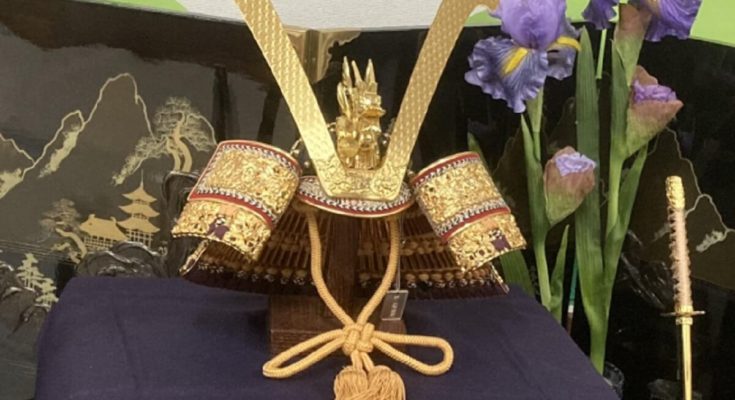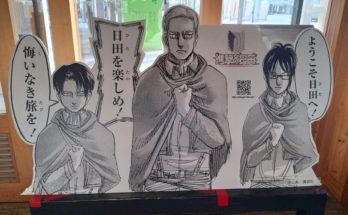Welcome to my first commemorable blog!
It has been almost a half-century since I was born.
However I don’t know much about many traditional costumes and events that are held in Japan.
So, I would like to share new discoveries that are originally from old Japanese traditions.
Today, I would like to write about 3 things in this picture. Green tea, Kabuto, and Kashiwamochi which are popular in the Children’s Day season.

1. New green tea season / Tea picking song
There are many ways to enjoy tea.
How to make tea is different depending on the tea leaves.
Drinking green tea is common in Japan.
Tea has been sold in bottles for over 4 decades, and the matcha latte is now popular in coffee shops. Matcha is a kind of green tea.
There is an old Japanese song that says something like:,
“Summer is coming around corner after the 88th night of Spring,
Young leaves starts growing in the field and mountain,
Look at over there, they are tea picking people with red ribbons and etc…”
Speaking of summer and spring , in short, in Japanese tradition, there are 24 divisions of the solar year. Japanese seasonal events often relate to the 24 divisions.
For example, early spring is called “Rishyun” (立春), 立 means stand, 春 means spring. Early summer is written as 立夏, 夏 means summer.
The song expresses the new tea, which is mainly green tea, and that harvest season has come, too.
The 88th day of spring is around the 2nd of May.
And as for tea picking people, if you would love to take part in a tea leaf picking tour, some owner or association will prepare it for you and your clothes. Some may serve your picking leaf as a tea and fry leaves like tempura, which is a popular method of cooking in Japan.
It is held in the Kyoto, Shizuoka, and Saitama prefectures, which are famous tea producing districts.

Speaking of New tea, we call it “Ichii ban Cha” (一番茶) in Japanese, which means the first tea.
It is the fastest growing leaf in each year, and is on the top of the tea branch.
After the first tea, the second can be harvested after 45 days or so.
It is said that the first, compared with the second, contains more caffeine and catechin.
The second is more bitter than the first, because of tannin.
How does the next come?
The third can be picked probably after one month after the second.
The fourth (which isn’t really the fourth but rather another side of the third) is called “autumn-winter” tea. It is not picked at the third timing; it is picked in autumn when leaves grow and keep nutrients.
The main difference between green tea and tea is the degree of fermentation; green tea isn’t fermented.
I know the first tea is a new one, but I don’t think deeply about the timing and fermentation of tea when I buy it.
So I will try to buy others to compare each of them this year.
2. Children’s Day / Kabuto
Have you ever seen a kabuto, the thing that lookslike a helmet in this photo below?
If you are hooked on baseball, you may have seen Otani Shohei put it on after he hit a homerun in the 2023 season of the LA Angels.
And in the first picture, there is a purple oragami that represents a kabuto.

It is said that kabuto were worn by samurai warriors to protect their head and body.
The kabuto is displayed as if it were still a charm and symbol of strength after the samurai war finished.
Time passes, and it becomes a parent’s wish for kids, especially male children, to grow up safe, sound, and strong.
Before the Children’s Day, that is the Japanese holiday on May 5th, kabuto and other kinds of things are displayed, such as dolls.
Why did I say “before”? It should be put on on auspicious days and during good weather, so, according to folklore and tradition, other times are bad.
On the kabuto, there are two strings that are called “O” (尾) that are used for tying the kabuto at the chin.
Also, two ornaments are put on the helmet. They are called “kuwagata” (鍬形), which expresses dignity.
A famous proverb says, “After we win the war, we should tie the strings up soon.”
That means, “you must watch out whenever anything goes well.”
Children’s Day is mainly for boys. When is the girl’s one? It is the 3rd of March, and it is called Hinamatsuri. The situation is similar to Children’s d\Day. When it comes, parents put out Japanese dolls for girls.
We need to prepare in advance for that one, too.
3. Children’s Day / Kashiwa mochi
We eat rice cakes, mainly kashiwa mochi, around Children’s Day.
Rice cakes have a wide variety of ingredients, cooking methods, and shapes.
For example, wrapped mochi with seaweed is a famous food during the New Year’s Day season in Japan.
Kashiwa leaf is oak leaf and mochi is rice cake.
So, kashiwa mochi is wrapped with oak/kashiwa leaf.
Inside of the mochi, there are sweet red beans. That is the major taste.
In addition, there are styles like mashed bean and smooth paste.
Kashiwa leaves don’t fall until a new leaf growing, so it is said that it indicates the prosperity of descendants.
Also, kashiwa leaf has some effects like bactericidal, drying prevention, and is easy to eat.
Mochi’s texture is sticky so once you eat with your fingers you must wash your fingers. Thus, kashiwa leaf works like plastic wrap.
Eating kashiwa mochi started in the Edo period, the rule of the Shogun which was -almost 400 years ago.
Mochi are naturally white because of the color of the rice, but for appearance, red and green ones exist.
Green ones are mixed with rice powder and yomogi (wormwood).
Additional: Origami / not in May
Origami is a 15 cm piece of paper. Usually, the surface is colored and the backside is white.
We usually made origami when we were in kindergarten or nursery school as a form of play and education. It is said that it began in the 4th century to cover things after paper was invented.
Origami is spreading now worldwide. The Nippon Origami Association sells books on how to make 100 origami shapes in English, Spanish, French, and Japanese.
Sometimes there are classes like “Let’s learn how to make origami cranes in English!” Origami cranes are so popular among Japanese people.
Especially when you make the 1,000 cranes that are given or donated for someone.
I made them several times for a friend who had to be hospitalized.
Each crane was bound by strings, and then some bundles are combined into a shape.
It can have many meanings: to live long, to become happy, to avoid disaster, to heal disease, and mainly to keep peace.
I learned how to make crane origami maybe 45 years ago, so I only remember some parts of the process. I’m so sorry that I can’t tell you how to make it.
Making origami needs precise work, so making crane origami makes our hands and brain better, I suppose.

On a final note, some traditions overlap with someone’s wishes and hopes.
Different traditions exist all over the world, but it often contains the same things: thought and soul.
I would like to know whether other countries’ traditions are similar to Japan’s or not.

I have been learning English for about 3 years. I have joined many kinds of English schools or social networking to get knowledge and skills for English since then.
My target for learning English is not so clear but my curiosity leads me to make a conversation with everyone in the world with English.
See you somewhere!





 HTJ has a YouTube page! Check it out
HTJ has a YouTube page! Check it out